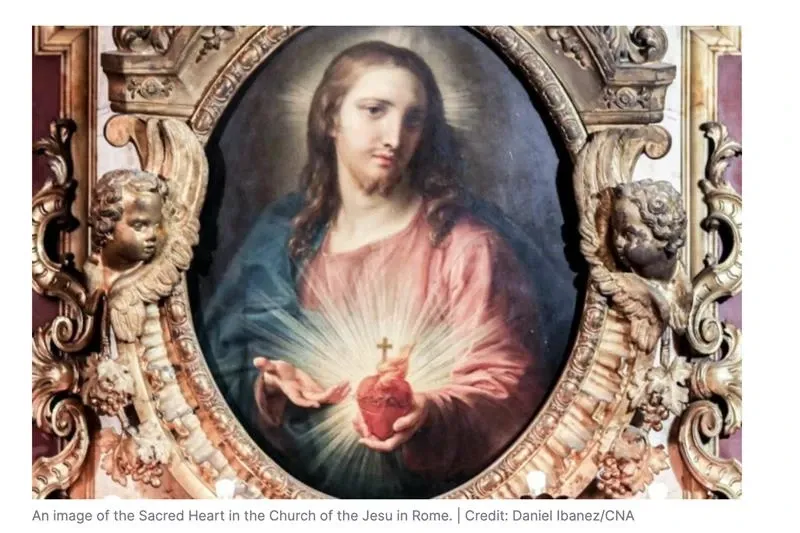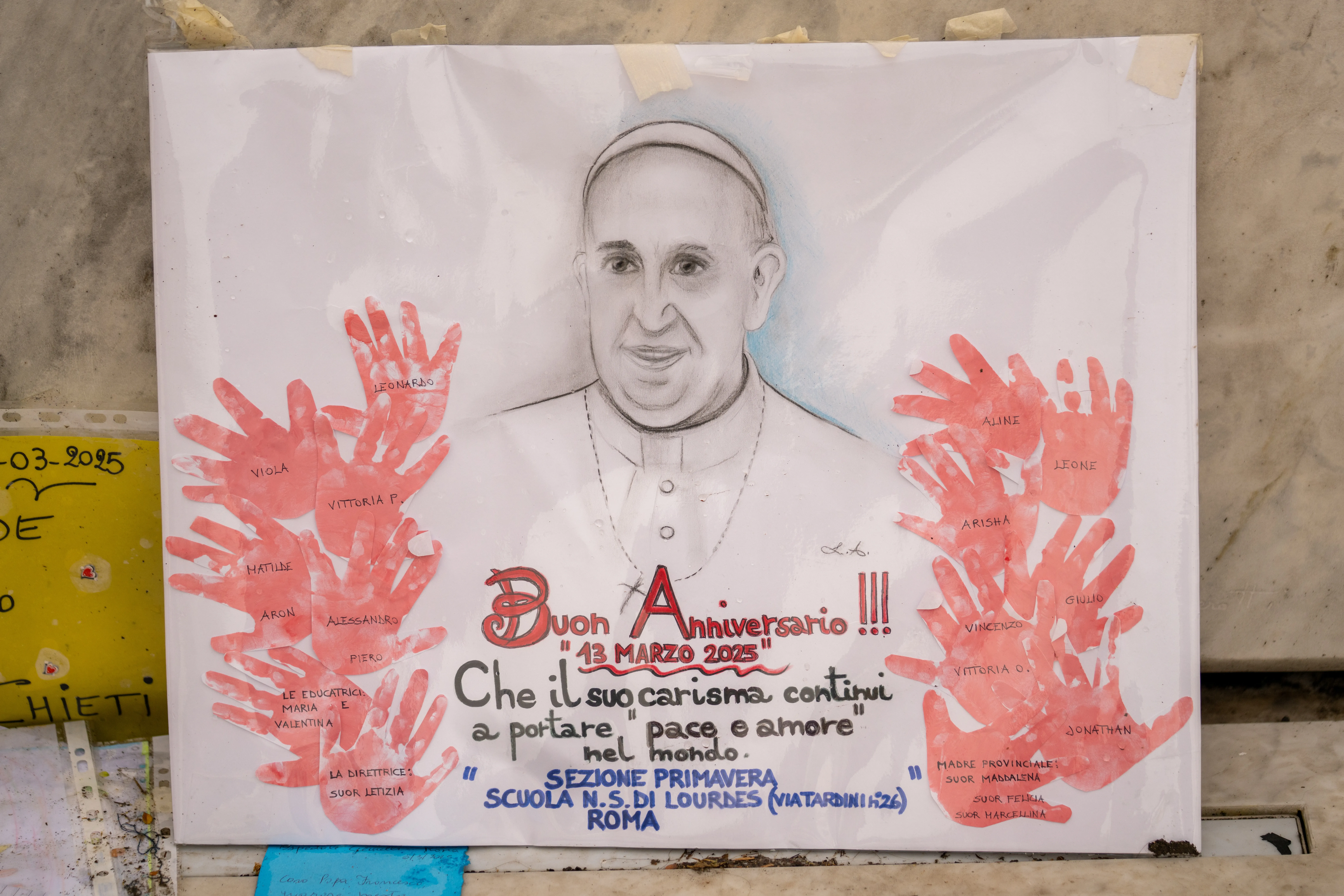The pope adds: “As we contemplate the heart of Christ, the incarnate synthesis of the Gospel, we can, following the example of St. Thérèse of the Child Jesus, ‘place heartfelt trust not in ourselves but in the infinite mercy of a God who loves us unconditionally and has already given us everything in the cross of Jesus Christ.’”
4. Love as a missionary impulse
Pope Francis also writes about “the communitarian, social, and missionary dimension of all authentic devotion to the heart of Christ,” adding that Christ’s heart not only leads us to the Father but also “sends us forth to our brothers and sisters.”
“Jesus is calling you and sending you forth to spread goodness in our world,” he writes. “His call is one of service, a summons to do good, perhaps as a physician, a mother, a teacher, or a priest. Wherever you may be, you can hear his call and realize that he is sending you forth to carry out that mission.”
Pope Francis also encourages parishes to focus less on structures and bureaucracies as means of evangelizing, warning against “communities and pastors excessively caught up in external activities, structural reforms that have little to do with the Gospel, obsessive reorganization plans, worldly projects, secular ways of thinking, and mandatory programs.”
(Story continues below)
The encyclical points to the missionary examples of saints like St. Thérèse and St. Charles de Foucauld. By returning to this Sacred Heart, he writes, Catholics can find a renewed energy to address social and spiritual challenges through love.
The pope writes about how the fire of the Holy Spirit fills the heart of Christ, quoting St. John Paul II’s letter on the 100th anniversary of Pope Leo XIII’s consecration of the human race to the divine heart of Jesus: “The heart of Christ is alive with the action of the Holy Spirit, to whom Jesus attributed the inspiration of his mission.”
5. Acts of reparation to the Sacred Heart of Jesus
In the encyclical, Pope Francis discusses the Catholic tradition of making acts of reparation to the Sacred Heart of Jesus, writing that “reparation entails the desire to render compensation” for the injuries inflicted on the Lord who is love.”
“The reparation that we offer is a freely accepted participation in his redeeming love and his one sacrifice,” he explains. “Acts of love of neighbor, with the renunciation, self-denial, suffering, and effort that they entail, can only be such when they are nourished by Christ’s own love. He enables us to love as he loved, and in this way he loves and serves others through us.”
“Sisters and brothers, I propose that we develop this means of reparation, which is, in a word, to offer the heart of Christ a new possibility of spreading in this world the flames of his ardent and gracious love,” Pope Francis said.
6. Saints and the Sacred Heart
In Dilexit Nos, Pope Francis shares insights from the saints and frequently cites the magisterium of his papal predecessors. He describes how St. Charles de Foucauld “consecrated himself to the Sacred Heart, in which he found a love without limits” inspiring his austere life in imitation of Christ, and how St. Thérèse placed her trust in the Sacred Heart’s infinite mercy.
He also points the reader to the spiritual experiences of St. Margaret Mary Alacoque, who experienced a remarkable series of apparitions of Christ between the end of December 1673 and June 1675.
In the first apparition, Jesus told Alacoque: “My divine heart is so inflamed with love for men, and for you in particular, that, no longer able to contain in itself the flames of its ardent charity, it must pour them out through you and be manifested to them, in order to enrich them with its precious treasures which I now reveal to you.”
Francis notes how Pope Leo XIII called for the world’s consecration to the Sacred Heart in response to the secular challenges of his time and Pius XI regarded the Sacred Heart as a “summa” of the experience of Christian faith. He also describes how St. John Paul II presented the growth of this devotion in recent centuries as “a response to the rise of rigorist and disembodied forms of spirituality that neglected the richness of the Lord’s mercy” and “as a timely summons to resist attempts to create a world that leaves no room for God.”
The encyclical also draws on thinkers like novelist Fyodor Dostoevsky and German philosopher Martin Heidegger to highlight the heart’s wider human relevance.
7. The wounded heart of Christ as a wellspring of peace and unity
As modern society faces what Francis calls a “wave of secularization” and division, he sees “the heart” as a source of unity.
“It is only by starting from the heart that our communities will succeed in uniting and reconciling differing minds and wills, so that the Spirit can guide us in unity as brothers and sisters. Reconciliation and peace are also born of the heart. The heart of Christ is ‘ecstasy,’ openness, gift, and encounter. In that heart, we learn to relate to one another in wholesome and happy ways, and to build up in this world God’s kingdom of love and justice. Our hearts, united with the heart of Christ, are capable of working this social miracle,” he writes.
The pope affirms that “the wounded side of Christ continues to pour forth that stream which is never exhausted, never passes away, but offers itself time and time again to all those who wish to love as he did.”
Pope Francis offers a prayer in the encyclical that the wounded world may regain its heart, writing: “In the presence of the heart of Christ, I once more ask the Lord to have mercy on this suffering world in which he chose to dwell as one of us. May he pour out the treasures of his light and love, so that our world, which presses forward despite wars, socioeconomic disparities, and uses of technology that threaten our humanity, may regain the most important and necessary thing of all: its heart.”
Courtney Mares is a Rome Correspondent for Catholic News Agency. A graduate of Harvard University, she has reported from news bureaus on three continents and was awarded the Gardner Fellowship for her work with North Korean refugees.








